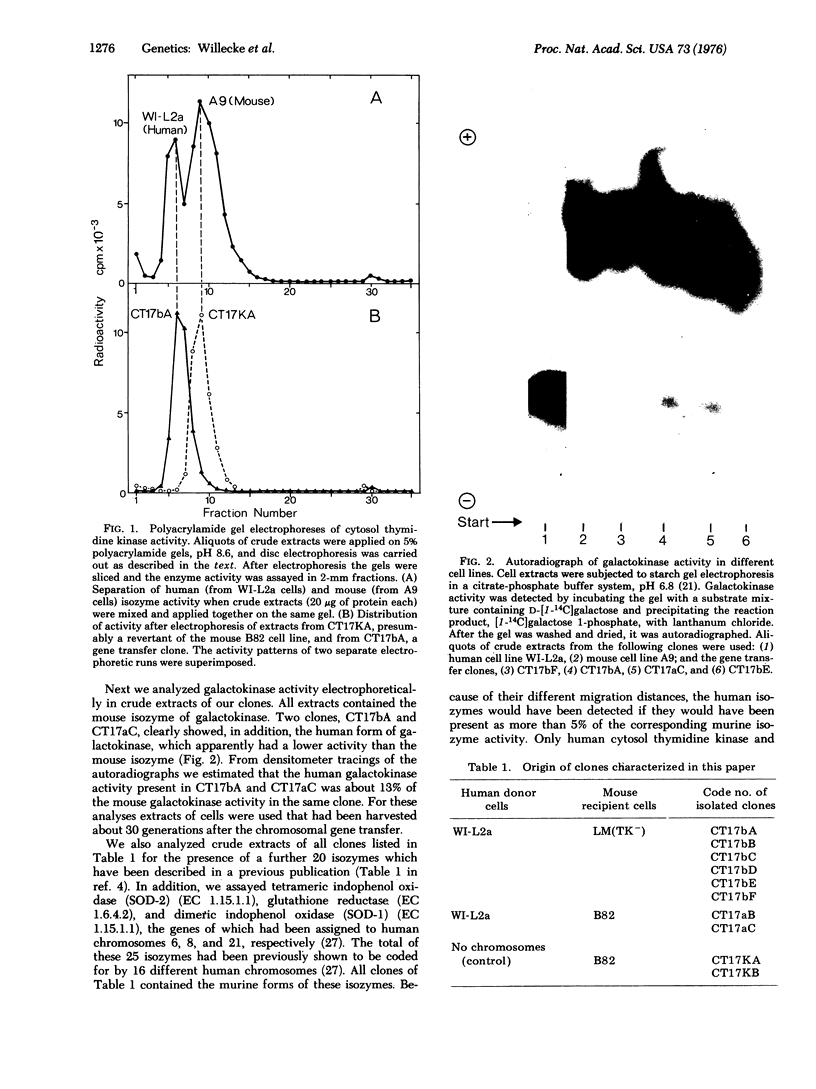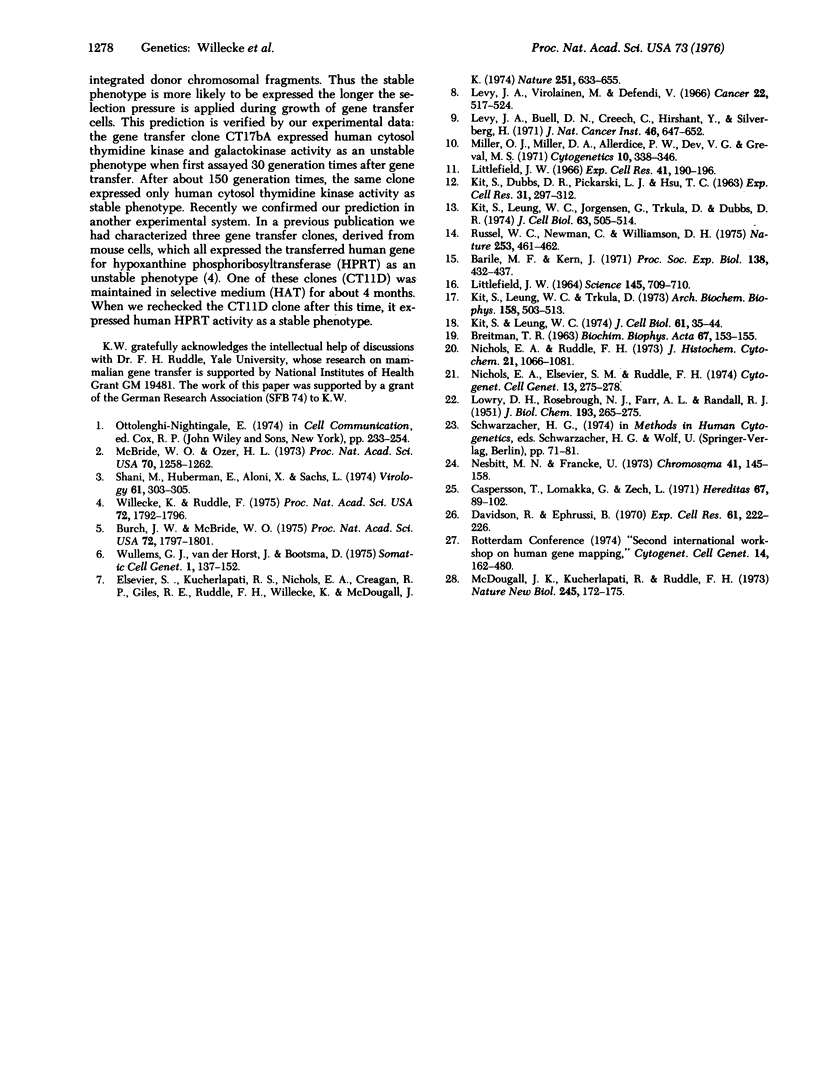Abstract
Two linked human genes which code for the expression of cytosol thymidine kinase (ATP:thymidine 5'-phosphotransferase, EC 2.7.1.75) and galactokinase (ATP:D-galactose 1-phosphotransferase, EC 2.7.1.6) have been cotransferred via purified metaphase chromosomes from the human lymphoblastoid cell line WI-L2a, into mouse L-cells [B82 and LM(TK-)]. Both genes have previously been shown to be closely linked on the human chromosome E17, band q21-22. Coexpression of both human enzyme markers was detected in two out of eight gene transfer clones, whilst the remaining six clones contained only human cytosol thymidine kinase, as shown by electrophoretic techniques. A further 23 human enzyme markers corresponding to 15 different human chromosomes were found to be absent in these gene transfer clones. No human chromosome or chromosomal fragment could be detected by karyotype analyses. Some of the gene transfer clones rapidly lost the transferred donor material when grown in nonselective medium, whereas others expressed a stable phenotype under these conditions. Prolonged maintenance in selective medium favors the survival of gene transfer cells expressing a stable phenotype. Possibly these cells harbor the donor genes integrated into a recipient chromosome.
Full text
PDF




Images in this article
Selected References
These references are in PubMed. This may not be the complete list of references from this article.
- BREITMAN T. R. The feedback inhibition of thymidine kinase. Biochim Biophys Acta. 1963 Jan 8;67:153–155. doi: 10.1016/0006-3002(63)91807-9. [DOI] [PubMed] [Google Scholar]
- Barile M. F., Kern J. Isolation of Mycoplasma arginini from commercial bovine sera and its implication in contaminated cell cultures. Proc Soc Exp Biol Med. 1971 Nov;138(2):432–437. doi: 10.3181/00379727-138-35913. [DOI] [PubMed] [Google Scholar]
- Burch J. W., McBride O. W. Human gene expression in rodent cells after uptake of isolated metaphase chromosomes. Proc Natl Acad Sci U S A. 1975 May;72(5):1797–1801. doi: 10.1073/pnas.72.5.1797. [DOI] [PMC free article] [PubMed] [Google Scholar]
- Caspersson T., Lomakka G., Zech L. The 24 fluorescence patterns of the human metaphase chromosomes - distinguishing characters and variability. Hereditas. 1972;67(1):89–102. doi: 10.1111/j.1601-5223.1971.tb02363.x. [DOI] [PubMed] [Google Scholar]
- Davidson R., Ephrussi B. Factors influencing the "effective mating rate" of mammalian cells. Exp Cell Res. 1970 Jul;61(1):222–226. doi: 10.1016/0014-4827(70)90282-x. [DOI] [PubMed] [Google Scholar]
- Elsevier S. M., Kucherlapati R. S., Nichols E. A., Creagan R. P., Giles R. E., Ruddle F. H., Willecke K., McDougall J. K. Assignment of the gene for galactokinase to human chromosome 17 and its regional localisation to band q21-22. Nature. 1974 Oct 18;251(5476):633–636. doi: 10.1038/251633a0. [DOI] [PubMed] [Google Scholar]
- KIT S., DUBBS D. R., PIEKARSKI L. J., HSU T. C. DELETION OF THYMIDINE KINASE ACTIVITY FROM L CELLS RESISTANT TO BROMODEOXYURIDINE. Exp Cell Res. 1963 Aug;31:297–312. doi: 10.1016/0014-4827(63)90007-7. [DOI] [PubMed] [Google Scholar]
- Kit S., Leung W. C. Genetic control of mitochondrial thymidine kinase in human-mouse and monkey-mouse somatic cell hybrids. J Cell Biol. 1974 Apr;61(1):35–44. doi: 10.1083/jcb.61.1.35. [DOI] [PMC free article] [PubMed] [Google Scholar]
- Kit S., Leung W. C., Jorgensen G., Trkula D., Dubbs D. R. Acquisition of chick cytosol thymidine kinase activity by thymidine kinase-deficient mouse fibroblast cells after fusion with chick erythrocytes. J Cell Biol. 1974 Nov;63(2 Pt 1):505–514. doi: 10.1083/jcb.63.2.505. [DOI] [PMC free article] [PubMed] [Google Scholar]
- Kit S., Leung W. C., Trkula D. Properties of mitochondrial thymidine kinases of parental and enzyme-deficient HeLa cells. Arch Biochem Biophys. 1973 Oct;158(2):503–513. doi: 10.1016/0003-9861(73)90542-0. [DOI] [PubMed] [Google Scholar]
- LITTLEFIELD J. W. SELECTION OF HYBRIDS FROM MATINGS OF FIBROBLASTS IN VITRO AND THEIR PRESUMED RECOMBINANTS. Science. 1964 Aug 14;145(3633):709–710. doi: 10.1126/science.145.3633.709. [DOI] [PubMed] [Google Scholar]
- LOWRY O. H., ROSEBROUGH N. J., FARR A. L., RANDALL R. J. Protein measurement with the Folin phenol reagent. J Biol Chem. 1951 Nov;193(1):265–275. [PubMed] [Google Scholar]
- Levy J. A., Buell D. N., Creech C., Hirshaut Y., Silverberg H. Further characterization of the WI-L1 and WI-L2 lymphoblastoid lines. J Natl Cancer Inst. 1971 Mar;46(3):647–654. [PubMed] [Google Scholar]
- Levy J. A., Virolainen M., Defendi V. Human lymphoblastoid lines from lymph node and spleen. Cancer. 1968 Sep;22(3):517–524. doi: 10.1002/1097-0142(196809)22:3<517::aid-cncr2820220305>3.0.co;2-a. [DOI] [PubMed] [Google Scholar]
- Littlefield J. W. The use of drug-resistant markers to study the hybridization of mouse fibroblasts. Exp Cell Res. 1966 Jan;41(1):190–196. doi: 10.1016/0014-4827(66)90558-1. [DOI] [PubMed] [Google Scholar]
- McBride O. W., Ozer H. L. Transfer of genetic information by purified metaphase chromosomes. Proc Natl Acad Sci U S A. 1973 Apr;70(4):1258–1262. doi: 10.1073/pnas.70.4.1258. [DOI] [PMC free article] [PubMed] [Google Scholar]
- McDougall J. K., Kucherlapati R., Ruddle F. H. Localization and induction of the human thymidine kinase gene by adenovirus 12. Nat New Biol. 1973 Oct 10;245(145):172–175. doi: 10.1038/newbio245172a0. [DOI] [PubMed] [Google Scholar]
- Miller O. J., Miller D. A., Allderdice P. W., Dev V. G., Grewal M. S. Quinacrine fluorescent karyotypes of human diploid and heteroploid cell lines. Cytogenetics. 1971;10(5):338–346. doi: 10.1159/000130152. [DOI] [PubMed] [Google Scholar]
- Nesbitt M. N., Francke U. A system of nomenclature for band patterns of mouse chromosomes. Chromosoma. 1973;41(2):145–158. doi: 10.1007/BF00319691. [DOI] [PubMed] [Google Scholar]
- Nichols E. A., Elsevier S. M., Ruddle F. H. A new electrophoretic technique for mouse, human, and Chinese hamster galactokinase. Cytogenet Cell Genet. 1974;13(3):275–278. doi: 10.1159/000130279. [DOI] [PubMed] [Google Scholar]
- Nichols E. A., Ruddle F. H. A review of enzyme polymorphism, linkage and electrophoretic conditions for mouse and somatic cell hybrids in starch gels. J Histochem Cytochem. 1973 Dec;21(12):1066–1081. doi: 10.1177/21.12.1066. [DOI] [PubMed] [Google Scholar]
- Russell W. C., Newman C., Williamson D. H. A simple cytochemical technique for demonstration of DNA in cells infected with mycoplasmas and viruses. Nature. 1975 Feb 6;253(5491):461–462. doi: 10.1038/253461a0. [DOI] [PubMed] [Google Scholar]
- Shani M., Huberman E., Aloni Y., Sachs L. Activation of simian virus 40 by transfer of isolated chromosomes from transformed cells. Virology. 1974 Sep;61(1):303–305. doi: 10.1016/0042-6822(74)90266-9. [DOI] [PubMed] [Google Scholar]
- Willecke K., Ruddle F. H. Transfer of the human gene for hypoxanthine-guanine phosphoribosyltransferase via isolated human metaphase chromosomes into mouse L-cells. Proc Natl Acad Sci U S A. 1975 May;72(5):1792–1796. doi: 10.1073/pnas.72.5.1792. [DOI] [PMC free article] [PubMed] [Google Scholar]
- Wullems G. J., van der Horst J., Bootsma D. Incorporation of isolated chromosomes and induction of hypoxanthine phosphoribosyltransferase in Chinese hamster cells. Somatic Cell Genet. 1975 Apr;1(2):137–151. doi: 10.1007/BF01538544. [DOI] [PubMed] [Google Scholar]



